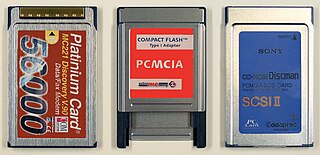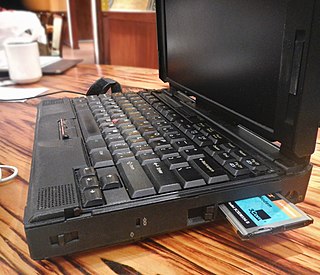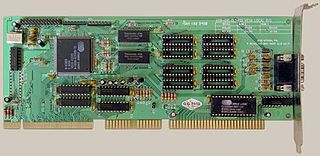
Industry Standard Architecture (ISA) is the 16-bit internal bus of IBM PC/AT and similar computers based on the Intel 80286 and its immediate successors during the 1980s. The bus was (largely) backward compatible with the 8-bit bus of the 8088-based IBM PC, including the IBM PC/XT as well as IBM PC compatibles.

PC Card is a parallel peripheral interface for laptop computers and PDAs.

Static random-access memory is a type of random-access memory (RAM) that uses latching circuitry (flip-flop) to store each bit. SRAM is volatile memory; data is lost when power is removed.

The Amiga 600, also known as the A600, is a home computer introduced in March 1992. It is the final Amiga model based on the Motorola 68000 and the 1990 Amiga Enhanced Chip Set. A redesign of the Amiga 500 Plus, it adds the option of an internal hard disk drive and a PCMCIA port. Lacking a numeric keypad, the A600 is only slightly larger than an IBM PC keyboard, weighing approximately 6 pounds (2.72kg). It shipped with AmigaOS 2.0, which was considered more user-friendly than earlier versions of the operating system.

The Personal Computer Memory Card International Association (PCMCIA) was a group of computer hardware manufacturers, operating under that name from 1989 to 2009. Starting with the PCMCIA card in 1990, it created various standards for peripheral interfaces designed for laptop computers.

In computing, an expansion card is a printed circuit board that can be inserted into an electrical connector, or expansion slot on a computer's motherboard to add functionality to a computer system. Sometimes the design of the computer's case and motherboard involves placing most of these slots onto a separate, removable card. Typically such cards are referred to as a riser card in part because they project upward from the board and allow expansion cards to be placed above and parallel to the motherboard.

A DIMM, or Dual In-Line Memory Module, is a popular type of memory module used in computers. It is a printed circuit board with one or both sides holding DRAM chips and pins. The vast majority of DIMMs are standardized through JEDEC standards, although there are proprietary DIMMs. DIMMs come in a variety of speeds and sizes, but generally are one of two lengths - PC which are 133.35 mm (5.25 in) and laptop (SO-DIMM) which are about half the size at 67.60 mm (2.66 in).

The Enhanced Graphics Adapter (EGA) is an IBM PC graphics adapter and de facto computer display standard from 1984 that superseded the CGA standard introduced with the original IBM PC, and was itself superseded by the VGA standard in 1987. In addition to the original EGA card manufactured by IBM, many compatible third-party cards were manufactured, and EGA graphics modes continued to be supported by VGA and later standards.

A memory card is an electronic data storage device used for storing digital information, typically using flash memory. These are commonly used in digital portable electronic devices, such as Digital cameras as well as in many early games consoles such as the Nintendo Wii. They allow adding memory to such devices using a card in a socket instead of protruding USB flash drives.

CompactFlash (CF) is a flash memory mass storage device used mainly in portable electronic devices. The format was specified and the devices were first manufactured by SanDisk in 1994.

Super VGA (SVGA) is a broad term that covers a wide range of computer display standards that extended IBM's VGA specification.

ExpressCard, initially called NEWCARD, is an interface to connect peripheral devices to a computer, usually a laptop computer. The ExpressCard technical standard specifies the design of slots built into the computer and of expansion cards to insert in the slots. The cards contain electronic circuits and sometimes connectors for external devices. The ExpressCard standard replaces the PC Card standards.

Thin small outline package (TSOP) is a type of surface mount IC package. They are very low-profile and have tight lead spacing.

In computing, a memory module or RAM stick is a printed circuit board on which memory integrated circuits are mounted.

The UltraLite was an IBM PC-compatible laptop released by NEC in October 1988. It was released alongside the heavier and more-capable ProSpeed. The UltraLite was based on the NEC V30 microprocessor; the computer includes MS-DOS 3.3 built into ROM.

The Amiga 1200, or A1200, is a personal computer in the Amiga computer family released by Commodore International, aimed at the home computer market. It was launched on October 21, 1992, at a base price of £399 in the United Kingdom and $599 in the United States.

The IBM Thinkpad 350 series was a notebook computer series introduced in 1993 by IBM as part of their Thinkpad laptop series. It was the successor to the IBM ThinkPad 300. With only 2 models ever made in the series, it was succeeded in 1994 by the IBM Thinkpad 360 series.

The Personal System/2 Model 30 and Personal System/2 Model 30 286 are IBM's entry-level desktop computers in their Personal System/2 (PS/2) family of personal computers. As opposed to higher-end entries in the PS/2 line which use Micro Channel bus architecture, the Model 30 features an Industry Standard Architecture bus, allowing it to use expansion cards from its direct predecessors, the PC/XT and the PC/AT. The original PS/2 Model 30 is built upon the Intel 8086 microprocessor clocked at 8 MHz; the Model 30 286 features the Intel 80286 clocked at 10 MHz.
New Media Corporation, also known as New Media Technology Corporation, was an American computer company active from 1992 to the early 2000s. The company focused on the design and manufacture of PC Cards, a type of expansion card bus for laptops that had their heyday from the early 1990s to the mid-2000s. New Media was privately held and based out of Irvine, California.

The Walkabout is a family of notebook-sized laptop computers introduced by Data General in 1989 and discontinued in 1993. The first entry in the line, simply named the Walkabout, was a battery-powered portable terminal capable of emulating multiple protocols; as well, it contains a rudimentary word processor, an autodialer utility for placing phone calls, and a real-time clock display and timer application for setting reminders. The successor to the first model, the Walkabout/SX, released in 1990, was an architectural redesign allowing the laptop to be used as a general-purpose IBM PC compatible. The penultimate entry, the Walkabout/320, increased its predecessor's i386SX processor clock speed from 16 MHz to 20 MHz, while the last entry in the line, the Walkabout/386SL, replaced the processor with Intel's portable-centric i386SL processor clocked at 25 MHz.




















